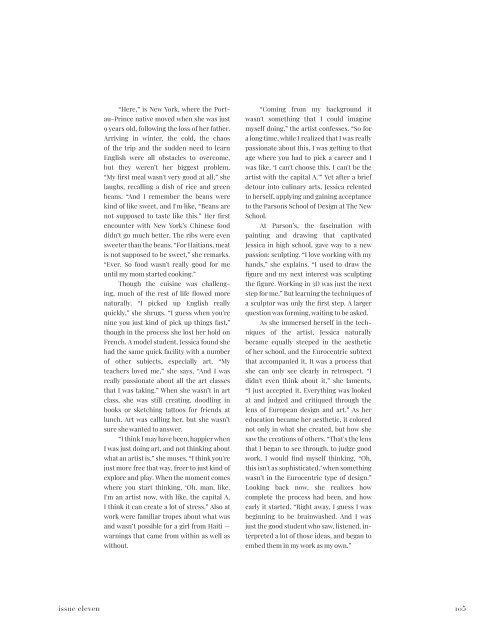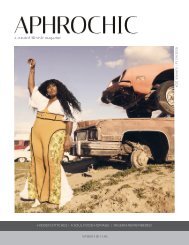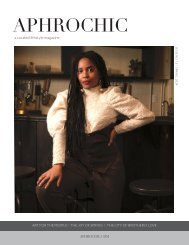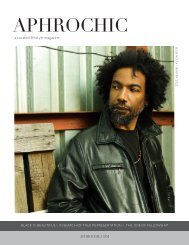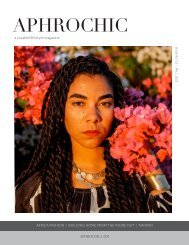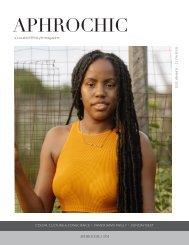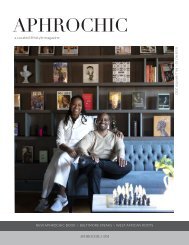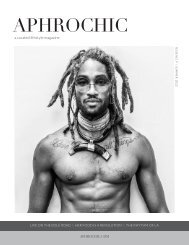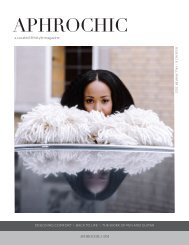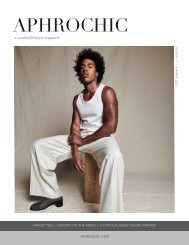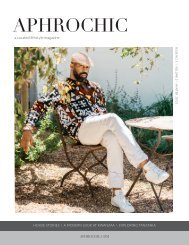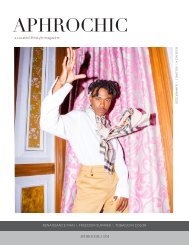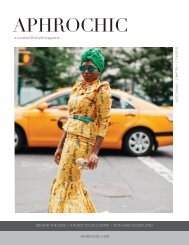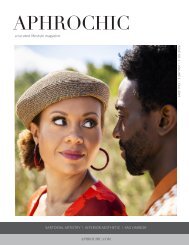AphroChic Magazine: Issue No. 11
You also want an ePaper? Increase the reach of your titles
YUMPU automatically turns print PDFs into web optimized ePapers that Google loves.
“Here,” is New York, where the Portau-Prince<br />
native moved when she was just<br />
9 years old, following the loss of her father.<br />
Arriving in winter, the cold, the chaos<br />
of the trip and the sudden need to learn<br />
English were all obstacles to overcome,<br />
but they weren’t her biggest problem.<br />
“My first meal wasn't very good at all,” she<br />
laughs, recalling a dish of rice and green<br />
beans. “And I remember the beans were<br />
kind of like sweet, and I'm like, “Beans are<br />
not supposed to taste like this.” Her first<br />
encounter with New York’s Chinese food<br />
didn’t go much better. The ribs were even<br />
sweeter than the beans. “For Haitians, meat<br />
is not supposed to be sweet,” she remarks.<br />
“Ever. So food wasn't really good for me<br />
until my mom started cooking.”<br />
Though the cuisine was challenging,<br />
much of the rest of life flowed more<br />
naturally. “I picked up English really<br />
quickly,” she shrugs. “I guess when you're<br />
nine you just kind of pick up things fast,”<br />
though in the process she lost her hold on<br />
French. A model student, Jessica found she<br />
had the same quick facility with a number<br />
of other subjects, especially art. “My<br />
teachers loved me,” she says, “And I was<br />
really passionate about all the art classes<br />
that I was taking.” When she wasn’t in art<br />
class, she was still creating, doodling in<br />
books or sketching tattoos for friends at<br />
lunch. Art was calling her, but she wasn’t<br />
sure she wanted to answer.<br />
“I think I may have been, happier when<br />
I was just doing art, and not thinking about<br />
what an artist is,” she muses. “I think you're<br />
just more free that way, freer to just kind of<br />
explore and play. When the moment comes<br />
where you start thinking, ‘Oh, man, like,<br />
I'm an artist now, with like, the capital A,<br />
I think it can create a lot of stress.” Also at<br />
work were familiar tropes about what was<br />
and wasn’t possible for a girl from Haiti —<br />
warnings that came from within as well as<br />
without.<br />
“Coming from my background it<br />
wasn't something that I could imagine<br />
myself doing,” the artist confesses. “So for<br />
a long time, while I realized that I was really<br />
passionate about this, I was getting to that<br />
age where you had to pick a career and I<br />
was like, ‘I can't choose this. I can't be the<br />
artist with the capital A.’” Yet after a brief<br />
detour into culinary arts, Jessica relented<br />
to herself, applying and gaining acceptance<br />
to the Parsons School of Design at The New<br />
School.<br />
At Parson’s, the fascination with<br />
painting and drawing that captivated<br />
Jessica in high school, gave way to a new<br />
passion: sculpting. “I love working with my<br />
hands,” she explains. “I used to draw the<br />
figure and my next interest was sculpting<br />
the figure. Working in 3D was just the next<br />
step for me.” But learning the techniques of<br />
a sculptor was only the first step. A larger<br />
question was forming, waiting to be asked.<br />
As she immersed herself in the techniques<br />
of the artist, Jessica naturally<br />
became equally steeped in the aesthetic<br />
of her school, and the Eurocentric subtext<br />
that accompanied it. It was a process that<br />
she can only see clearly in retrospect. “I<br />
didn't even think about it,” she laments.<br />
“I just accepted it. Everything was looked<br />
at and judged and critiqued through the<br />
lens of European design and art.” As her<br />
education became her aesthetic, it colored<br />
not only in what she created, but how she<br />
saw the creations of others. “That's the lens<br />
that I began to see through, to judge good<br />
work. I would find myself thinking, “Oh,<br />
this isn't as sophisticated,’ when something<br />
wasn’t in the Eurocentric type of design.”<br />
Looking back now, she realizes how<br />
complete the process had been, and how<br />
early it started. “Right away, I guess I was<br />
beginning to be brainwashed. And I was<br />
just the good student who saw, listened, interpreted<br />
a lot of those ideas, and began to<br />
embed them in my work as my own.”<br />
issue eleven 105


